
Bergslagskanalen
| 
|
Canal between Karlskoga, Storfors and Filipstad in Värmland.
The millowners wanted to speed up the transports. Primarily to the shipping harbour Kristinehamn at lake Vänern. For this purpose a roller conveyor was built from Sjöändan to Kristinehamn, marked with green on the map at right. Sjöändan is at the southern end of lake Bergsjön and to get the goods to that harbour the Norsbäck canal was built during the 1630ies.
Karlskoga and Bofors got connected to Sjöändan in 1852 when the fairway in Timsälven was improved and the canal and lock at Knappfors was built.
In 1857 the canals at Asphytte and Bjursbäck were opened for traffic giving mills and tradesmen in the Filipstad area fast connecting to Sjöändan and Kristinehamn.
The works in Storfors came last. On their own expence they built Prästbäcken canal, but not until 1906, when practically all other freighttraffic on the canal had ceased.
Storforsälven from the southern part of Storfors is navigable and ends in lake Öjevettern.
There have been plans to canalize Timsälven all the way to lake Möckeln. From Möckeln there have been plans to canalize Letälven to lake Skagern and further via Gullspångsälven to lake Vänern. This part, from Skagern to Vänern has been part of most of the proposals for a canal from lake Mälaren, via lake Hjälmaren, to lake Vänern, the so called Svea canal. None of these plans have been realized.

The upstream lock in Bjurbäcken on a drawing by J.H. Strömer published in "Wermland i teckningar" from 1858 - 1867 by Franz von Schéeles and Uno Troilis.

| 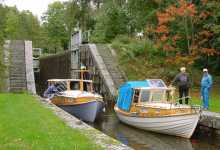
| 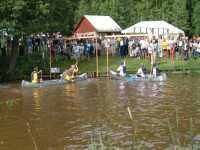
|
Asphyttan lifting bridge
| The Bjurbäcken locks
Picture: Arne Larsson
| Canoe competition in 2002
Picture: Jan Olsson
|
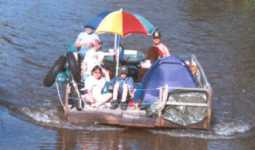
| 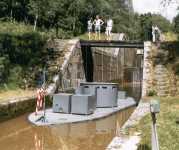
| 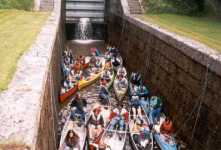
|
"Floating" on Bjurbäcken canal
Picture: Rolf Nilsson
| Monitor in Bjurbäcken locks
Picture: Rolf Nilsson
| Canoes in Bjurbäcken locks
Picture: Rolf Nilsson
|
Total length
| Total elevation
| Number of locks
| Max boatlength
| Max boatwidth
| Max draught
| Max free height
| Max speed
|
64 km
| 16 m
| 6
| 20,7 m
| 3,6 m
| 1,2 m
| 2,1 m
| knots
|
History:
What now is known as Bergslagens Canal is actually a number of small canals built at different periods. Today they are all cared for as cultural monuments and used mainly by tourists.
The reason why these canals were built is of course the need for fast and cheap transport of iron from the many rich mines and works in the area to lake Vänern and further to Gohtenburg for export.
The roads in the area were sparce and bad, so they used the many lakes. But moving the goods from one lake to another was expensive and time-consuming.
Most of all the work-owners wanted a fast connection to Kristinehamn at lake Vänern. This was the big harbour with connection to Gothenburg. The first canal was built in the 1630ies. It was Norsbäcks canal between the two lakes Hyttsjön and Bergsjön. This is one of the oldest canals in Sweden, but still it could take several months for a cargo to come from Filipstad to Kristinehamn.
From Filipstad to Kristinehamn 20 000 skeppund bar iron was transported every year 200 years ago. That equals to 4 000 tons. Knowing that a horsdrawn carriage carried 2 skeppund you realize the urge for efficient boattransport.
During the 18th century several proposals were made for simplifying the transports. One of these came from the owner of Storfors that in 1775 proposed a canal from Sjöändan to Kristinehamn. But nothing happened.
In the early 19th century the tradesmen in Filipstad demanded and got a new investigation. There were many protests against the proposal so nothing was done.
In 1833 the work-owners around Filipstad called lieutenant colonel J. Edström and asked him to invstigate all previous surveys to find which was best. They paid Edström themselves. Within one month Edström proposed a canal, as it is today, from Filipstad to Sjöändan, and a roller conveyor from Sjöändan to Kristinehamn.
After another 14 years a canal company was established to build and operate the canal and in 1853 the works started. In spite of primitive methods the work was made fast and in 1857 the canals at Bjurbäcken and Asphyttan could be inaugurated and opened. Bjurbäcken canal is 3 kilometer long and connects lake Stora Lungen to lake Aspen, while Asphytte canal is 275 meter long and connects lake Aspen to lake Daglösen.
The canal company had estimated the cost to 130 000 SEK. The actual cost was 308 000 SEK. And still, the canal was a great success!
In 1874 Östra Värmlands Järnväg, Eastern Värmland Railroad, was opened for traffic and attracted almost all important transports. Freight traffic on the canal ceased and actually stopped in 1876. There was still some passenger traffic, but that did not give money enough for proper maintenance of the canal. Ironically the railroad company owned the canal.
In 1917 the railroad and the canal came in the hands of Statens Järnvägar, SJ, and maintenance got worse. From 1936 the canal was not a public fairway. This meant that the company could stop opening the bridges over the canal for boats.
But most people in the area wanted to keep the canal as a historical monument and in 1939 Föreningen Filipstads Bergslags Kanal was founded. In 1945 this society got an agreement with the government which gave it the right to use the canal and in 1947 it was once again opened after many large renovations. Since 1952 the canal is a public fairway.
Since then the society has renovated the canal intensively and they maintain the canal in the best of manners. It is now a very popular place for tourists, coming both on land and on water.
The most intensive traffic on the canal was between 1865 and 1875. 1 369 steamers and 3 243 barges passed in 1872 which that year was only superceeded by Trollhätte canal. Some 30 steamers were engaged in scheduled passenger traffic at this time.
The canal's highest yearly income was 25 500 SEK in 1872.
Before Filipstad got it's connection to Sjöändan with Bjurbäcken canal and Asphytte canal, a canal with lock was built at Knappfors. This was done between 1850 and 1852 and gave Bofors and Karlskoga direct connection to Sjöändan.
Another of the ideas evolved during the 18th century was realized as late as 1906 when Storfors works built and paid for a canal between lake Daglösen and lake Östersjön.
Statistics about traffic up to 1900
Canalparts:
 Asphytte canal:
275 meter long, built 1853 to 1857, one lock with 5 meter elevation.
Asphytte canal:
275 meter long, built 1853 to 1857, one lock with 5 meter elevation.
Click on the map to see more pictures from the lock and the canal.
 Bjurbäcken canal:
3 kilometer long, built 1853 to 1857, four locks 10,8 meter elevation.
Bjurbäcken canal:
3 kilometer long, built 1853 to 1857, four locks 10,8 meter elevation.
Click on the map to see more pictures from the locks and the canal.
 Knappfors canal:
Knappfors canal:
125 meter long, built 1850 to 1852, one lock with 0,9 meter elevation.
Click on the map to see more pictures from the lock and the canal.
 Norsbäck canal:
Norsbäck canal:
1,4 kilometer long, built in the 1630ies.
 Prästbäcken:
Prästbäcken:
2 kilometer long, built 1906. Narrow and curved.
Click on the map to see more pictures of the canal.
| 
The lock keeper's lodge in Bjurbäcken
|
Sources: Information from Föreningen Filipstads Bergslags Kanal. They have a website.
Do send comments or further information to Bosse Arnholm!
 Click here to get back to the startpage.
Click here to get back to the startpage.
This page was modified at

